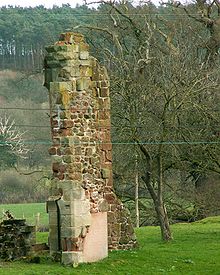- Myddle
-
Myddle, also known as Mydle, Middle, Midle, M'dle, Meadley and Medle is a small village in Shropshire, England about 10 miles north of Shrewsbury, the county town of Shropshire. Myddle lies in the parish of Myddle with Broughton-le-Strange. The 2001 census recorded a population of 1,142 in the village.
Please see extensive web site detailing history and village information at http://www.myddle.net
A book was written about Myddle in the 18th century, History of Myddle. The author Richard Gough describes the town and its ongoings, and uses it as a study of human relations. The book has been called "the greatest insight into that group of people,"[1] that group of people being the 'middle sort of people' in Early Modern England.
Contents
History
For extensive history information please visit http://www.myddle.net/index.cfm/history/
The village of Myddle was occupied by 1066, with a manor house for Earl Siward of York completed in the 1050s.[2]
By 1086, the year of the Domesday Book under William the Conqueror, the manor house was occupied by Rainald the Sheriff. During the 12th century, the Fitz Alan family of Clun occupied the manor house, with John Le Strange acquiring it around 1165.
In 1234, Myddle was the location of the signing of a treaty between King Henry III and Welsh Prince Llewellyn.
In Sept. 2005 and Sept. 2007 a detectorist uncovered a small number of hammered gold coins dating back to the 14th century.[3]
The Le Stranges' dynasty ended in 1580 due to the lack of male heirs to the estate, and Myddle passed to the Earl of Derby after he married Joan Le Strange. Their son, Thomas, became the second Earl of Derby.
Elizabeth I granted Thomas Barnston a licence to sell land in Myddle in 1596, and in 1600 Sir Thomas Egerton purchased the village. Egerton's son was elected by James I to become the first Earl of Bridgewater in 1579.
During the English Civil War in 1642, Charles I recruited 20 men from Myddle, with 14 killed.[4]
Myddle suffered an earthquake in 1688, but continued to expand throughout the coming centuries, with butchers' shops, taverns, fishmongers and masons inhabiting the village by about 1850.
The manor house was destroyed and sold in pay the death duties of the third Earl Brownlow in 1924.
In 1901 the village was graced by a visit of The All American Trumpeters who put on a free show to raise funds for a memorial to Queen Victoria.
In 1942, during the Second World War, an RAF Whitley bomber crashed in Myddle after taking off from nearby Sleap Airfield.
Myddle Castle
A castle was constructed in Mydle between 1308 and 1310 by Lord John Le Strange as a stronghold against the Welsh after the family obtained a licence to convert the manor house into a castle.
Sometime around 1449, Elizabeth Cobham received the castle as part of her dowery from Richard, 7th Lord Strange. After Lord Strange died, Cobham married Sir Roger Kynaston in 1450. Elizabeth died in 1453, and left the castle to Kynaston. Upon Roger's death in 1495, his son Humphrey Kynaston inherited the castle, but allowed it to fall into disrepair, and abandoned it some time later.
The castle has stood empty since the 16th century, with one visitor to the village, John Leland, describing the castle as veri ruinus around 1540.
The castle collapsed during an earthquake in 1688.
The castle was repaired by John Hume Egerton in 1849,[5] who inscribed his name into a block in the castle's wall.
The castle is now a Grade II Listed Building and, since a portion collapsed in 1976, has been scheduled for repair.[6]
Culture
Myddle fete is held on the first Saturday of July in the grounds of the village school.
Notable residents
- Richard Gough, author of "Antiquities and Memories of the Parish of Myddle", and "Observations concerning the seats in Myddle and the families to which they belong" was born in 1635 and died in 1723. He was educated in Myddle and Broughton, and lived at Newton on the Hill. Although Gough's writings are not currently in print, a freely available digitised version created by Google can be accessed here Google Archive
To celebrate the 300th anniversary of Gough's account of village life, a group of 18 local people created an illustrated pack of six walks around Myddle which have become known as the 'Gough Walks'. Further information about these can be found by following the 'Walk & Cycle' link from the myddle.net homepage
- Jas Mann, lead singer of Babylon Zoo[citation needed]
- Phil Collins, Badminton Player (silver medal 1988 Olympics)
- Edward Stollins, co-founder of Our Price (chain of record shops, no longer in business)
- Humphrey Kynaston, highwayman
References
- ^ French, H.R. Social Status, Localism, and the 'Middle Sort of People' in England 1620–1750
- ^ The Anglo-Saxon Chronicle – CHAPTER XII
- ^ More gold coins from the Myddle Hoard, Shropshire | Treasure Hunting
- ^ Myddle, Shropshire, England – History
- ^ Myddle, Shropshire, England – History
- ^ British Listed Buildings Online
Sources
- G. Grazebrook and J.P. Rylands, The Visitation of Shropshire taken in the year 1623 (Harleian Visitations) Part 1 (London 1889). (Myddle family pedigrees)
- R. Gough, The History of Myddle (Ed. with Introduction and Notes by David Hey). (Penguin, Harmondsworth 1981).
- D. Hey, An English Rural Community: Myddle under the Tudors and Stuarts (Leicester University Press 1974).
External links
 Media related to Myddle at Wikimedia CommonsCategories:
Media related to Myddle at Wikimedia CommonsCategories:- Villages in Shropshire
Wikimedia Foundation. 2010.

